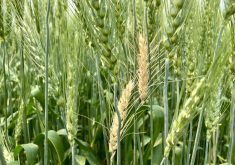CNS Canada –– As harvest winds to a close across the Prairies, some feedlot operators say they’ve noticed more feed barley and feed wheat out there than they initially thought.
The quality of the feed varies greatly, with some second-cut wheat being accepted as high-quality with reasonable protein, while other loads arrive with sprouting, bleaching and fusarium.
Prices in Lethbridge’s feedlot alley continue to hang steady at $210-$215 per tonne for barley and $215-$220 per tonne on wheat.
Jim Beusekom, of Market Place Commodities near Lethbridge, said it’s a real mixed bag.
Read Also

U.S. grains: Wheat futures rise on supply snags in top-exporter Russia
U.S. wheat futures closed higher on Thursday on concerns over the limited availability of supplies for export in Russia, analysts said.
“On a year like this where you have everything from high fusarium to sprouting to just low protein or bleached-out wheat, that does create different feed values, even in our market.”
Feedlots aren’t buying in large volumes right now, which has left the cash market relatively flat, he said.
He and his staff also have to closely examine the supplies they’re receiving.
“Fusarium wasn’t an issue last year, but this year we’re finding fusarium is a big issue in the feed wheat and we really have to be careful bringing feed wheat into Alberta,” he said, adding commercial buyers require low levels of fusarium vomitoxin.
Another industry watcher agreed, saying farmers who managed to bale a first cut before July’s rains arrived then profited off the quality of their second cut, because they were able to plant it in time to take advantage of warm fall weather.
“Guys that didn’t get their first cut off in July, they have some very poor-quality, very mature, weather-damaged… low-protein stuff,” said Barry Yaremcio of the provincial Ag-Info Centre in Stettler.
As for Beusekom, he expects more feed wheat to arrive soon. “More of that grain should start coming to market; offset with more demand, we should see markets steady through the early winter into the New Year.”
— Dave Sims writes for Commodity News Service Canada, a Winnipeg company specializing in grain and commodity market reporting.















